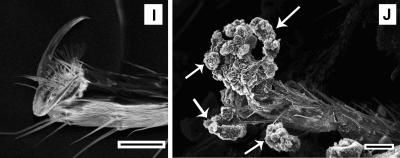'Edible optics' could make food safer
Tufts researchers design bio-friendly optical platform for sensing applications in medicine, health, environment, communications
Imagine an edible optical sensor that could be placed in produce bags to detect harmful levels of bacteria and consumed right along with the veggies. Or an implantable device that would monitor glucose in your blood for a year, then dissolve.
Scientists at Tufts University's School of Engineering have demonstrated for the first time that it is possible to design such "living" optical elements that could enable an entirely new class of sensors. These sensors would combine sophisticated nanoscale optics with biological readout functions, be biocompatible and biodegradable, and be manufactured and stored at room temperatures without use of toxic chemicals. The Tufts team used fibers from silkworms to develop the platform devices. Tufts University has filed a number of patent applications on silk-based optics and is actively exploring commercialization opportunities.
"Sophisticated optical devices that are mechanically robust yet fully biodegradable, biocompatible and implantable don't exist today," said principal investigator Fiorenzo Omenetto, associate professor of biomedical engineering and associate professor of physics. "Such systems would greatly expand the use of current optical technologies in areas like human and livestock health, environmental monitoring and food quality."
"For example, at a low cost, we could potentially put a bioactive silk film in every bag of spinach, and it could give the consumer a readout of whether or not E. coli bacteria were in the bag - before the food was consumed," explained David Kaplan, professor and chair of the biomedical engineering department.
Silk proteins are, literally, a natural for integrating optical and biological functions. They can be processed in water at ordinary temperatures and patterned on the nanoscale to generate a wide range of optical elements, including ultrathin films, thick films, and nanoscale and large-diameter fibers. Silk proteins also offer excellent surface quality and transparency, which are perquisites for high-quality optics. Equally important, they are mechanically robust.
To form the devices, Tufts scientists boiled cocoons of the Bombyx mori silkworm in a water solution and extracted the glue-like sericin proteins. The purified silk protein solution was ultimately poured onto negative molds of ruled and holographic diffraction gratings with spacing as fine as 3600 grooves/mm. The cast silk solution was air dried to create solid fibroin silk films that were cured in water, dried and optically evaluated. A similar process was followed to create lenses, microlens arrays and holograms. Film thicknesses from 10 to 100 µm were characterized for transparency and optical quality. The variety and quality of the optical elements compared favorably with conventional platforms and outperformed other commonly used biopolymers.
However, the most compelling feature of the platform, according to the Tufts researchers, is that the elements are prepared, processed and optimized in all-aqueous environments and at ambient temperature. This makes possible the inclusion of sensitive biological 'receptors' within the solution that stay active after the solution has hardened into a free-standing silk optical element.
The Tufts team embedded three very different biological agents in the silk solution: a protein (hemoglobin), an enzyme (horseradish peroxidase) and an organic pH indicator (phenol red). In the hardened silk optical element, all three agents maintained their activity for long periods when simply stored on a shelf. "We have optical devices embedded with enzymes that are still active after almost a year of storage at room temperature. This is amazing given that the same enzyme becomes inactive if forgotten and left unrefrigerated for a few days," said Omenetto."
The Tufts research was published in a recent paper in "Biomacromolecules" by Brian D. Lawrence, graduate student in biomedical engineering; Mark Cronin-Golomb, associate professor, biomedical engineering; Irene Georgakoudi, assistant professor, biomedical engineering; Kaplan, and Omenetto.
Other news from the department science
These products might interest you
Most read news
More news from our other portals
See the theme worlds for related content
Topic world Sensor technology
Sensor technology has revolutionized the chemical industry by providing accurate, timely and reliable data across a wide range of processes. From monitoring critical parameters in production lines to early detection of potential malfunctions or hazards, sensors are the silent sentinels that ensure quality, efficiency and safety.

Topic world Sensor technology
Sensor technology has revolutionized the chemical industry by providing accurate, timely and reliable data across a wide range of processes. From monitoring critical parameters in production lines to early detection of potential malfunctions or hazards, sensors are the silent sentinels that ensure quality, efficiency and safety.

































































